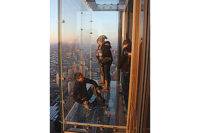Surrounded by a residential complex, as well as the city's busiest expressway, the 74-year-old Shanghai Concert Hall has been plagued with noise and exhaust fumes for years. Although building a new concert hall would have been less expensive, the city chose to move the entire building to preserve its distinctive architecture. Constructed in the early 1900's and formerly known as the Nanking Theater, the hall is renowned for its excellent acoustics, and has been the setting for many orchestral performances since 1959.
Moving the decades-old building took place in three phases, the first of which involved lifting the entire structure 5.5 feet from its original foundations. After that, it was moved 216 feet to the southeast. The third and final phase involved lifting the hall another 5.4 feet and then lowering and positioning it onto a new base.
Before the actual relocation project began, engineers spent 7 months strengthening and collecting data on the inside structure. During the entire lifting and moving process, a variety of data-collection tools and instruments recorded every change.
To actually lift and support the building, which weighs over 5,800 tons, engineers used a fully integrated system from Enerpac (Milwaukee), comprised of 59 cylinders with a capacity of 200 tons per cylinder and four large hydraulic pump stations with the ability to both weigh and lift. A central programmable logic controller directed and monitored all movements.
Due to the design of the original foundation and the lack of an integrated frame, the building was extremely difficult to lift and move. For that reason it was first lifted 5.6 feet and positioned onto a 1,800-ton armored concrete tray. This tray was then used to help slide the building along 10 custom-poured concrete tracks. The building was also reinforced with steel straps both inside and out to provide additional support.
The entire 216-foot journey took 12 days. Because the tracks could only withstand the weight of the concert hall for about 10 days, 10 additional large hydraulic cylinders were installed underneath the building to take the strain.
On day 1, the building moved less than 16 inches. During the first 5 days, the total distance moved was only about 11 feet. After that, the building attained a speed of 6.5 feet per hour. The greatest distance covered in a single day was 54 feet.
Once at the new site, the hydraulic cylinders made the final lift so a new foundation could be molded to dovetail with the building. With that done, workers could set about upgrading the building itself, enlarging the stage and adding a basement so the facility will have more room for staging future productions.
For more on heavy lifting and positioning, call 262-781-6600 or visit www.enerpac.com.
